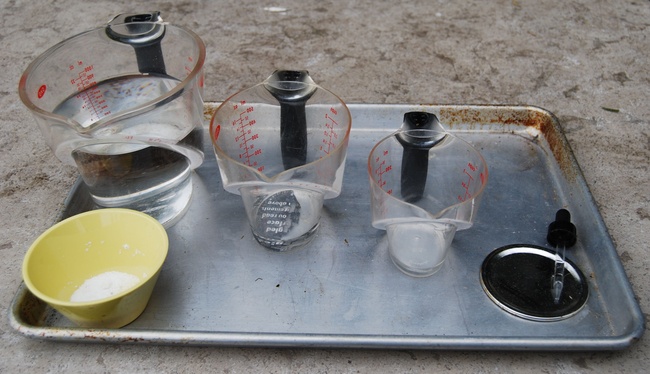Garden Science: Drop in the Bucket

Summary
In this 6th grade science class, students consider how they use water in their daily lives and learn that water is a nonrenewable resource in a closed system.
Objectives
After this lesson, students will be able to:
- Recognize that only a small fraction of water on planet Earth is clean, drinkable, and accessible
- Identify water as a nonrenewable resource in a closed system.
- Recognize their own water consumption
Assessments
During this lesson, students will:
- Observe the water demonstration
- Explain that water is in a closed system.
- Connect their actions with water consumption while playing a game called The Wind Blows
Materials
- 1000ml beaker (or container of similar size)
- 3 clear containers of descending size (for example, 1 cup beaker, small glass, small bowl)
- Eyedropper
- Salt
- Cards for The Wind Blows game
- Pie chart visual aid of clean drinkable accessible water
Before You Begin
- If you have a rainwater catchment system, research the average rainfall in your region and how many gallons your rainwater catching system can collect for the water tank math problems.
- Collect all the materials
- Arrange the 4 containers in descending size
- Fill the 1000ml container with water
- Create the cards for The Wind Blows game
Procedures
At the Opening Circle
- Welcome students and introduce water as a precious resource that is impacted by the choices we make everyday.
- Begin the drop in the bucket demonstration by inviting students to use their imagination and visualize the entire earth.
- Focus attention to pie chart visual aid and encourage students to reference the chart while following your demonstration.
- Hold up the largest beaker of water (1000ml) and ask students to imagine that this beaker holds all of the water on planet earth. Ask where they would expect to see most of this water if they were looking down from outer space. Explain that most of the earth’s water is locked up in oceans and seas, which means about 97% of earth’s water is salt water.
- Pour out 30ml from the beaker into the next largest container, explaining that this represents the 3% of the Earth's water that is fresh water. Sprinkle salt in the remaining 97% percent to illustrate the point.
- Hold up the 30ml of water and ask students which state of matter they think most of this fresh water is in. About 80% of Earth’s freshwater is actually solid and locked up in glaciers or polar ice caps, while only 20% is in a liquid state. Now pour 6ml into the next container to demonstrate the amount of fresh water that is liquid.
- Hold up the remaining 6ml and ask students where they think the rest of the fresh water is found. Guide them to think about the lakes, rivers, reservoirs and aquifers that hold fresh water. Point out that most of the water is actually deep underground.
- Ask students what effect humans can have on water that affects its drinkability. (pollution)
- Now hold the dropper and conclude by dropping a small drop of water in the last container, for all students to see. Explain that most of the remaining freshwater is either inaccessible or is polluted. This small drop represents all the water on planet earth that is clean accessible drinking water, which is 0.3% of the total that we began with. The rest is salty, frozen, too hard for us to reach or polluted.
- Prompt students to think about all ways that we use this small percentage of water.
- Ask students to consider whether water is in a closed or open system and what that means in terms of how much water exists on planet earth. Guide students to understand that water is in a closed system and non-renewable.
- Explain that students will learn about one way we try to conserve water by visiting the rainwater catchment tanks. Tell students that in Closing Circle they will play The Wind Blows, a game about many of the ways that we use 0.3% of water daily.
- Divide the class into groups for garden jobs. During garden work time, take each group to visit the water catchment system.
At the Water Catchment Tank
- Explain how your school’s system works and share facts about how much water it catches. At the Edible Schoolyard Berkeley, each tank holds 3,000 gallons of water and for every inch of rainfall 200 gallons of water are saved in the tanks.
- Incorporate a math problem for your small group to figure out.
- Example: How many inches of rainfall are needed to fill up each tank?
- If there are 27 inches of rainfall in Berkeley on average each year, how many gallons can we expect to be in the tanks each year?
- Ask students to think critically about the purpose of rainwater catchment.
At the Closing Circle
Play The Wind Blows, a game similar to musical chairs. To start the game a teacher reads a statement, and all students for whom the statement is true stand up and change seats. The last student standing without a seat reads a follow-up to the statement and then reads the next statement. In this particular instance of the game, the statements are about water consumption.
Vocabulary
Closed system
Open system
Aquifer
States of matter